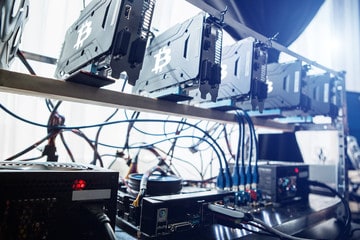Ethereum mining can be a wonderful way to understand what cryptocurrency is all about as well as gaining integral technical knowledge while earning a consistent profit. Before starting it’s imperative to learn how to mine Ethereum and read at least a couple of guides about the subject.
Ethereum by design depends on proof of work, aka mining. This means that individual users completely provide computing power in order to validate blocks as well as transactions. When this happens, Ethereum or ETH is earned during the process.
While Bitcoin was the first cryptocurrency to introduce mining, it has become increasingly difficult to earn money from bitcoin mining. It is for this reason that Ethereum mining became a captivating alternative for cryptocurrency users, especially for the computer components used in mainstream computing.
Upfront Costs
While higher hash rates can provide increased revenue, it is still crucial to consider things such as electricity efficiency, depreciation, and upfront costs. It is surprising to some to know that it could take years to recoup the upfront capital of any device either an ASIC or a GPU.
A major disadvantage is that ASICS quickly becomes obsolete. It is even possible for an ASIC to become useless if developers choose to change the mining protocol associated with Ethereum.
Even if this is not the case and an intentional change is not made, manufacturers of ASIC tend to have trouble publishing updated firmware.
Compared to ASICs, GPUs will always have a resale value thanks to the fact that they can be useful for system performance and gaming in general.
That being said, continuous mining could result in the GPUs wearing out, especially if they do not get adequate cooling and proper maintenance. That being said, they are still a lot easier to resell compared to ASICs because they have other use cases besides cryptocurrency mining.
Ethereum can be mined using previous generation, low end, or even integrated GPUS. Nevertheless, the profit margin for that setup is bound to be quite small.
Moreover, electric costs could cause your ethminer rig to lose you more money than you make overall. This is why you have to know what your electricity expenses are going to be before you start.
Things to remember before starting your own Ethereum mining rig
Should you decide to be an ethminer and create numerous rigs to boost your ethash, it is best to stick to one brand of PSU or power supply unit.
This enables you to have additional cables that can be used on any of the other systems should a need arise. So long as your system can meet the prerequisites and comes with 1 3 gig ram GPU, you should be able to mine Ethereum.
You might consider using a gaming laptop as your rig given that they tend to have high-end cards. However, this would be the wrong thing to do given that mining would generate considerable heat and that could impact other aspects of the laptop. For this reason, it is always best to use a desktop build.
Setting up your mining rig as an ethminer
When it comes to selecting the hardware you intend to mine with, you will have to experiment with quite a number of varying GPU selections. You should bear in mind that Nvidia cards are outperformed by AMD cars when it comes to cryptocurrency mining.
Your selected card should come with a minimum of 3 Gigs of ram. Anything less will hamper its ability to effectively mine Ethereum. The minimum ram requirement is down to the increasingly large directed acyclic graph or DAG file utilized by Ethereum’s proof of Work hashing process.
When it comes to the requirements of the operating system, you have to ensure that you use the latest iteration of Windows, which is Windows 10. Additionally, it has to be 64 bit.
While there are numerous Linux distributions, Windows is still the most seamless operating system to set up and have running as quickly as possible.
At this juncture, there isn’t a Macintosh version. Nevertheless, there are a couple of things you have to cover when creating your own mining rig
You will have to get a motherboard that comes with sufficient PCI-E slots in order to help support all the cards you intend to run. Should you utilize more than a single GPU, you will want to have a powered PCI-E riser that attends to every additional GPU.
This is why it is important to double or even triple-check that the power supply unit or PSU comes with a sufficient number of connections that support the GPUs you intend on running.
Additionally, you should also ensure that you have an overall wattage that cannot only support your entire system’s power draw but also leave you with a little buffer room.
This will involve you getting a low end or previous generation CPU that comes with 4 gigs of ram as a minimum. You also have to ensure that the RAM, CPU, and motherboard was chosen are all compatible.
It is also imperative that you remember to use a power button. Having a basic power button that can be connected to the motherboard’s headers enables you to switch the system off and on. You will require a standard mouse, monitor, and keyboard.










